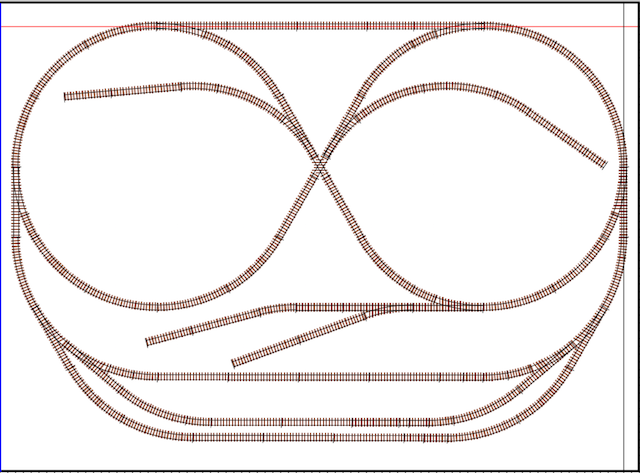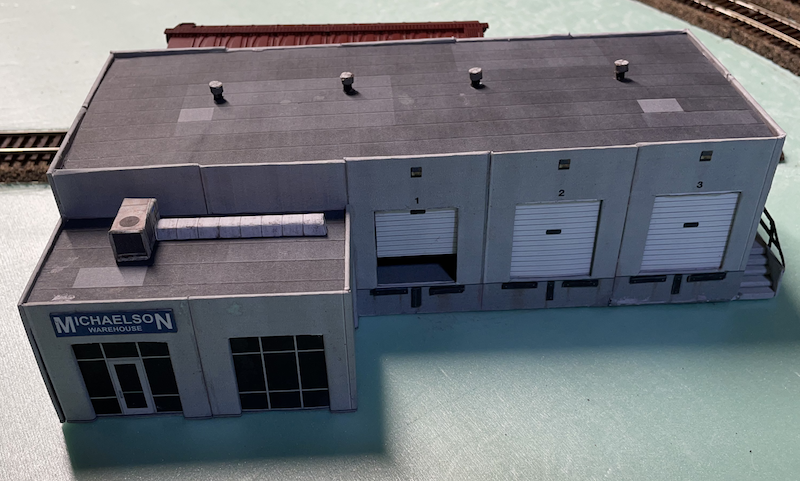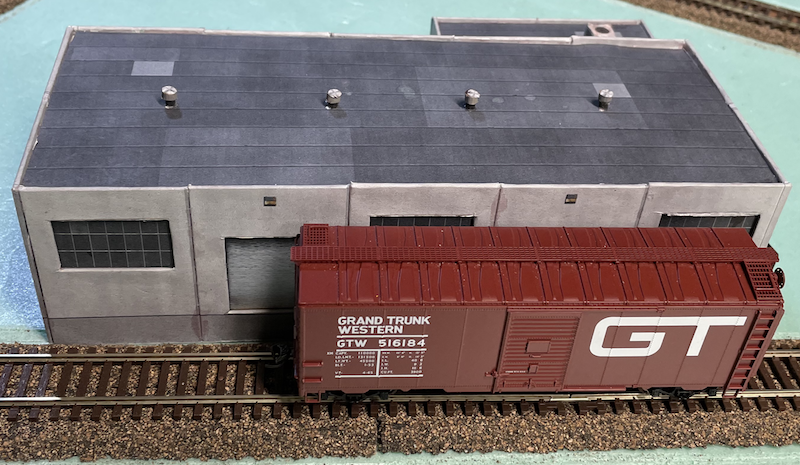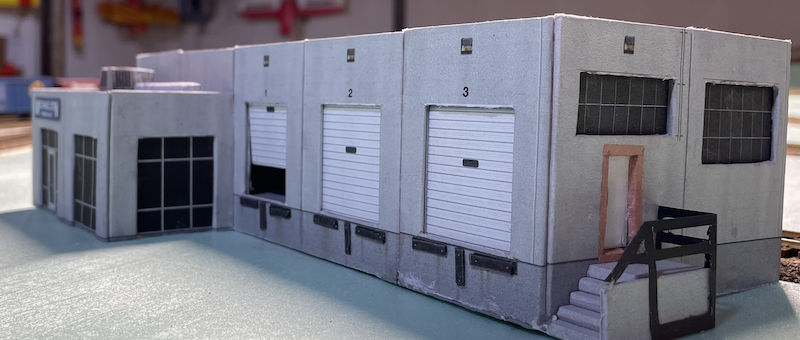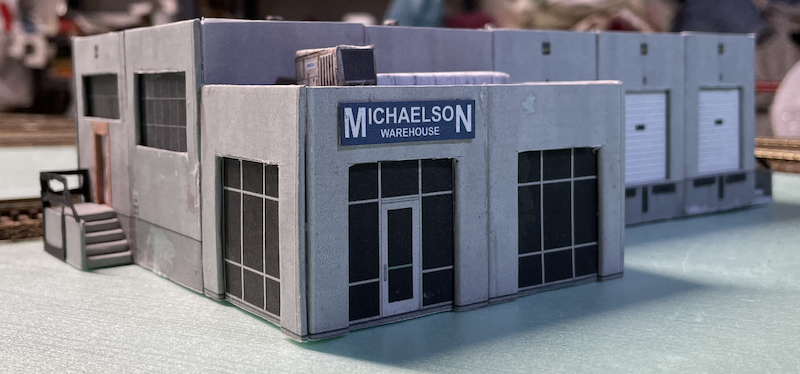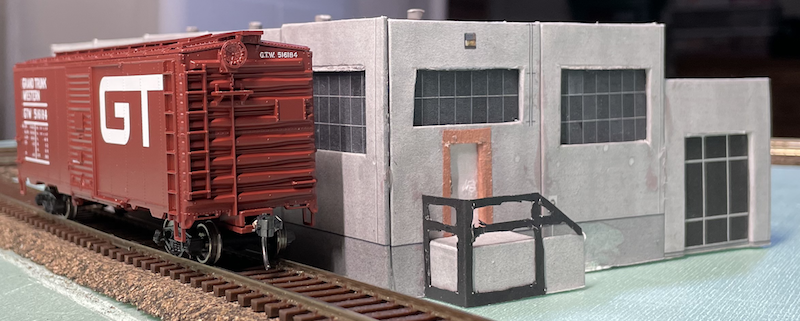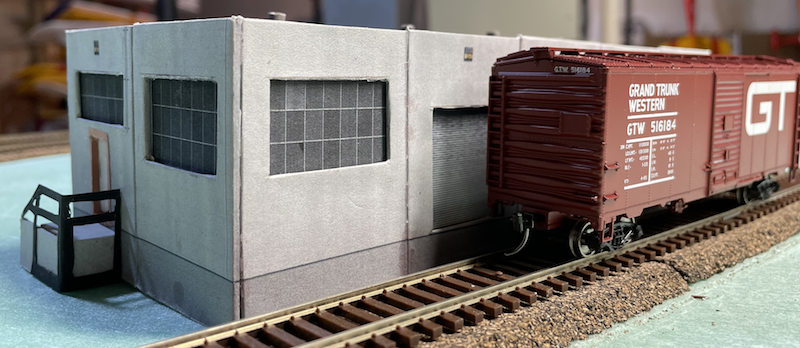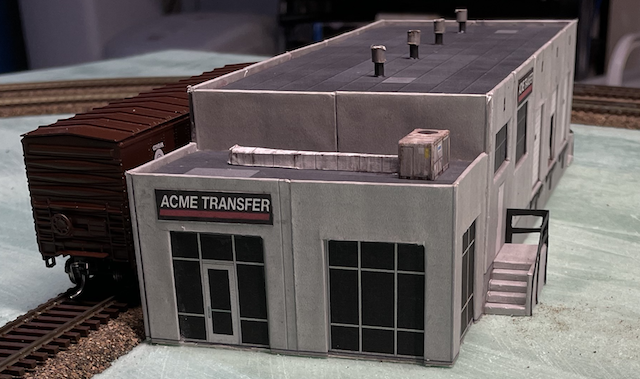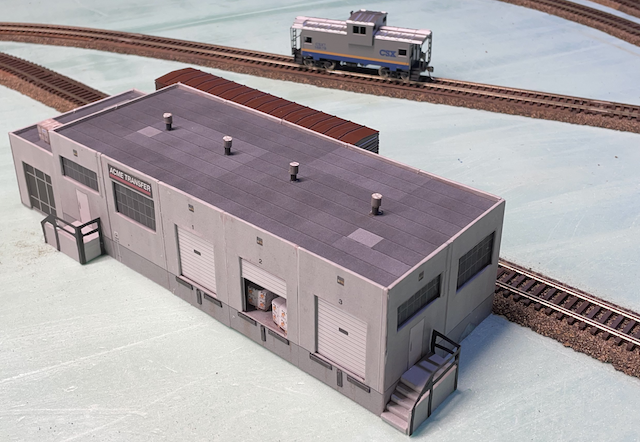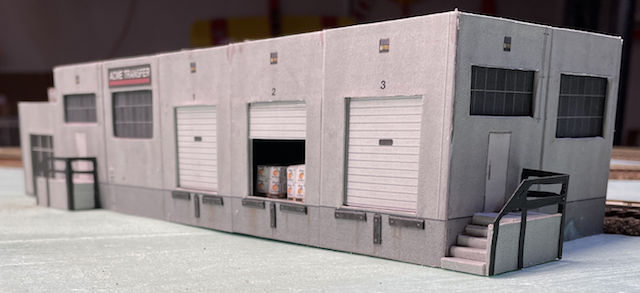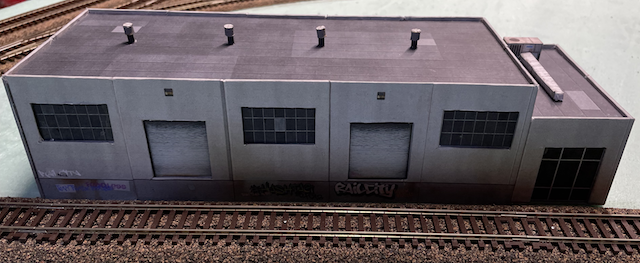By Ken Myers Email Ken Latest Update - October 2025 A PDF with links to all Model Railroading applicable links on YouTube Six Part Series on YouTube "Are You Ready to Give Dead Rail a Try?" Lots of details and examples in the videos. April 2, 2025
Now, when searching the Internet, the search results present a lot of videos, information, etc. regarding the Roblox Dead Rails game.
I just wanted to make you aware of this. Purpose: This Website was started to document my journey into investigating how the hobby of model railroading, specifically HO Scale model railroading, had evolved since I was last involved, which was over thirty years ago. Why? My main hobby is building, designing, and flying radio controlled (RC) airplanes, and for the last 40+ years, pioneering and promoting the use of electric power for RC fixed wing model aircraft.
For my Dead Rail system, I have chosen the LocoFi™ sound module, along with the FREE LocoFi™ Android App for an Android phone. Together, they are used to control the locomotive's speed and direction and produce several locomotive sounds, including engine, bell and horn or whistle, depending on whether the locomotive is diesel powered or steam powered. The power to run the locomotive and the LocoFi™ module is provided by a battery pack.
LocoFi™ now offers the LocoFi™ system preinstalled in two ways! The LocoFi™ system is offered preinstalled in a locomotive or in a locomotive as part of a train set. Click Here to View LocoFi's™ latest offerings. The links below open in a new tab in your browser. A Word About Safety
What I've Learned So Far
Getting Started - The Train Set Arrived
It Runs!
Batteries and Chargers That I Use for Dead Rail/Battery on Board
Installation of the LocoFi™ Module In the Diesel Locomotive and How the Trailing Battery Cars Were Created
Steam Comes to the Middleton & South Haven
An ALCO RS-3 Comes to the Middleton & South Haven
Using the FREE LocoFi™ App
Running Time Using Batteries
A Prototype Portable Foam Board Layout
A Summary at the End of August 2022
My First HO Train Layout in a Long, Long Time
Testing the "Real World" Layout and Getting It All Working Smoothly
All About the Rolling Stock
Operation of the Middleton & South Haven Railway
Some Tools, Supplies and Adhesives
Let There Be Light
Train "Shows", Sales and Model Railroad Club Meetings
Adding Structures
More Structure Building Information (in PDF format)
Learning TinkerCAD Why I started using TinkerCAD for 3D printing and why it won't work for printing HO scaled doors, windows and their frames for paper and cardstock structures.
The Structures
My YouTube Videos
Progress or NOT?!? - It's all the little things
YouTube Channels That I Enjoy and Have Found Useful
X-Track CAD and an alternative tutorial for the Mac Only
Helpful Online Resources
Archived Data
The National Model Railroad Association (NMRA) Website has a list of some of the risks that are associated with scale model railroading. Before continuing, please take the time to gain the knowledge put forth in this listing; "NMRA Safety Page". The link opens the Safety page in a new tab. After reading through their information, just close the tab to return to this page. This article has numerous references to Dead Rail. Dead Rail uses a rechargeable battery pack, carried onboard the train, to power the locomotive and the LocoFi™ sound module. There is not really room in an HO locomotive body shell for a relatively safe, usable battery pack, therefore it is placed in a type of rolling stock that can be used as a battery car while trailing the locomotive. (Note: While a conversion to Dead Rail using a Li-Po battery in the locomotive shell is demonstrated in this article, it is NOT RECOMMENDED. Hobby grade Li-Po type batteries are not the SAFEST choice for general use in Dead Rail applications for HO.) Introducing batteries into the system requires that the user has a thorough knowledge about the safety concerns and risks for the various types of Lithium Ion (Li-ion) rechargeable batteries and how to mitigate some of the risk when using batteries to power any device. The intent of this article is to deepen the reader's knowledge base and it is not to be used as a how-to without ALL of the proper knowledge, skills and risk assessment. 1. HO scale (1:87) is still the most popular scale to model in the US and Canada. 2. The number of scale model train manufactures and suppliers of track, locomotives, rolling stock, power supplies, cab controllers, and accessories has dwindled a lot since I was last involved in the hobby, which was from 1956 through the late 1980s.
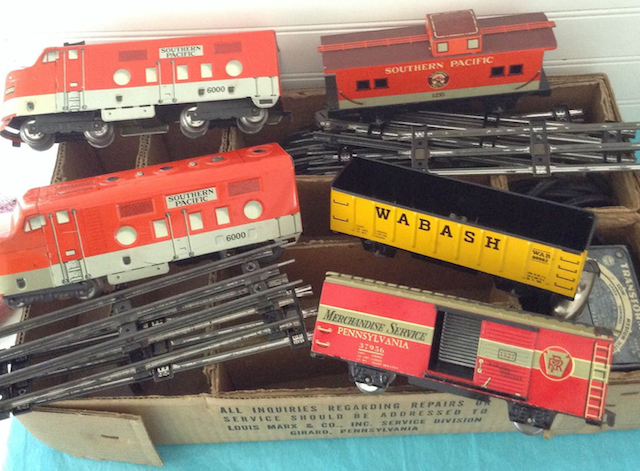
My first electric train set, in 1956, was identical to the one I found in this Internet photo, although I did have a MARX "wind-up set" before that. 3. Overall, the number of hobby shops, and those specializing in model railroading, have also dwindled to just a few. Therefore, obtaining an item, to be used on a given day, is difficult. Purchasing items from the Internet requires planning well ahead of when the item is expected to be needed. 4. Model Railroading is a many faceted hobby. Even in the HO scale niche, individuals determine which aspect of the hobby they will concentrate on at a given time, but there is a lot of fluidity between each aspect over time. They are all great! 5. At first, the prices for the items that are required, or desired, to be a model railroader, today, in 2023, seemed high to me.
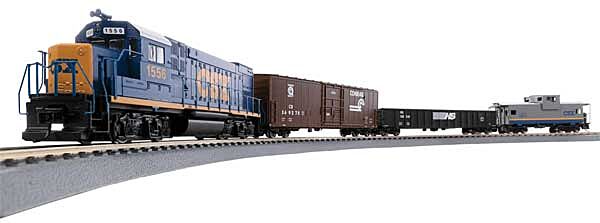
Photo from www.walthers.com/trainline-trainset-2021-csx In February 2022, I purchased, through Amazon, a Walthers Trainline HO Scale 1/87 Flyer Express Fast-Freight Train Set - CSX Transportation for $199.98. Whew! Expensive! but... $199.98 divided by 5.59 = $35.78 in 1975 money, and that falls into line with what I remember for a mid-line quality HO set back then. (Note that the 5.59 was the difference when the calculations were made in Oct. of 2023.) 
Inflation Chart based on $200 dollars If you are thinking of scale model railroading as a hobby, but think that it is too expensive, maybe thinking about the following can clarify your thinking.
6. Using the principle of KISS, keep it super simple, is invaluable when applied to model railroading. 7. DC (direct current) track power is hardly used anymore, by the majority of model railroaders today, to power model locomotives. It has been surpassed by some implementation of DCC (Direct Cab Control), even in "simple beginner train sets". DCC allows for the speed control of the locomotive (Cab) plus sounds, lights and more. The link in this paragraph is to the NATIONAL MODEL RAILROAD ASSOCIATION, INC. (NMRA) Website. The NMRA is the organization that sets the standards for model railroading. The NMRA standards for DCC were adopted in 1993. 8. The idea for powering scale model trains with batteries on board goes back at least 30 years, or more, when a few folks tried using batteries and RC (radio control) systems from inexpensive toy cars that used battery power and had a means of speed control as well as being able to move in both forward and reverse.
9. Having discovered that battery power was at least possible, X-TrackCAD, a FREE track planning CAD program, was learned and used to design possible, future layouts. The following are a few of my early track/layout plans, while learning X-Track CAD.
10. While designing a possible future layout using X-Track CAD, LocoFi™ was discovered, researched, was available and then ordered. The "DC 9V - 24V supported", noted in the graphic, indicates that it can be used for battery power. (Since that graphic was created by LocoFi™, the specs have changed and the low voltage is now 7V.)
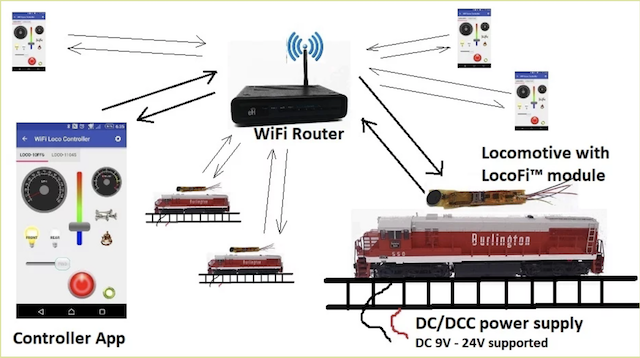
Diagram from the LocoFi™ Website The LocoFi™ system was chosen because it was available at the time this project was started. It has proved to be very reliable, well thought out and very user friendly, plus the LocoFi™ Team is absolutely top notch in giving assistance and feedback.
11. Near the middle of August 2022, Soundtraxx announced its new Blunami system. They partnered with BlueRail Trains, which provides the iOS App to control all of the Blunami's features and control the locomotive. It is now another Dead Rail/Battery on Board viable system.
12. The only change in benchwork construction for model train layouts seems to be the addition of 1" to 2" thick foam insulation board to top the flat areas of the benchwork. Foam insulation board is sold in 4'x8' sheet sizes at places that sell lumber.
13. I found that turnouts can be physically switched remotely and do not require electrical connections to do so. This is especially useful for Dead Rail operations. A commercial example is the BULLFROG by Fast Tracks. There are also several examples of how to DIY these types of remote switch machines on YouTube. 14. There are a lot of tools and supplies required to be a model railroader! A great deal of knowledge, including the safe use of tools, as well as knowledge of electrical and battery safety, and excellent modeling skills are also required to be successful, but more importantly, safe. 15. There are no percentage details as to how many model railroaders are using DC track power, DCC or battery power for powering their locomotives, but battery power, Dead Rail, has to be the lowest percentage. 16. This was probably the worst time, near the beginning of 2022, to start looking into HO scale model railroading again. The common things, such as Atlas track, were in short supply, as well as many other useful and commonly used model railroading products.
17. While the majority of model railroading information on YouTube is supplied by seniors, there are also a lot of "younger" guys, from their teens through their 40s and 50s, that are also providing information and inspiration about scale model railroading. 18. Extreme flexibility of thought is required as well as the ability to pivot when a new idea, or problem arises. Items that are required in an original thought might not be available. A substitution, or new idea, might be required to continue. Thoughts and ideas will frequently change. Sometimes "sleeping on it" brings up new thoughts and ideas to solve a problem. 19. Patients is indeed a virtue! Everything will take a lot longer to do than you might "think" it should, everything! 20. Information regarding Lithium-based, rechargeable, secondary batteries, posted on YouTube and some Websites, varies greatly in accuracy. Sorting the "wheat" from the "chaff" is extremely difficult for someone not familiar with these types of batteries. 21. There are a lot of various uses and users for Lithium-based batteries that range from the obvious, electric vehicles (EVs), laptop computers, smart phones, tablets, radio controlled (RC) vehicles and the like to solar energy users, RVers, preppers, tactical flashlight users, vapors and Nerf Blaster users. Useful information can be garnered from some YouTube videos and Websites posted by all of these users, as well as a lot of misinformation. 22. Keeping current with cylindrical Li-ion, 10440 battery size, manufactures, suppliers (in the USA or Canada) and in-stock sources has proved to be quite difficult. The most current information can be found here, and should be checked before continuing with this document. I now only use 10440 size in places, like steam engine tenders, where space is restricted. For diesels, I use 14500 size Li-ions in a trailing battery car. 23. Selecting a first track layout attempt is EXTREMELY DIFFICULT! There are so many variables involved that it takes a LONG time to consider all of the possible variables. That process can become overwhelming and even debilitating, which can stop the process in its tracks. Reaching a decision, and actually getting started proved very daunting to ME. My "journey" is described in the archived section titled, "My First HO Train Layout in a Long, Long Time; the process" 24. There are hundreds of YouTube channels that feature many aspects of model railroading.
Near the end of November 2022, over 200 of these channels were previewed. 1. Approximately 1/4 (1 out of 4 people) of the creators of those channels did not finish their layouts to an operational point before they either stopped posting or moved on to different "hobbies". 2. Approximately 1/4 (1 out of 4 people) of the creators of those channels finished their layouts to an operational point before they either stopped posting or moved on to different "hobbies". 3. Approximately 2/4 (2 out of 4 people) continued to post about their layout's progress and/or continued to provide information relating to the model railroad hobby. How this data relates to the "real world" is unknown. My personal opinion is that it correlates well. 25. It is best to purchase track and the like from a "real" train store with an online presence. One example is Yankee Dabbler, in New Jersey. Amazon is not a reliable source, and should not be used. Yankee Dabbler also has a presence on YouTube when new, instock products are presented in their videos. 26. It is a good idea to keep notes in some type of journal or log during the build so that they can be referred to in the future. A folder to keep receipts and other paper instructions is also a good idea. 27. Have good, bright lighting in the area where the layout is being built. While recording video, or photographing, the layout might require some special lighting for the photo or video. Bright lighting the layout area is essential when doing track work and working on scenic details. 28. Woodland Scenics has a lighting system called the "Just Plug® Lighting System". It makes lighting "plug and play" easy. They have a "Battery Case" accessory for two 9V batteries that makes using with Dead Rail/Battery on Board super easy.
29. Throughout this article, I explain, at various points, how I determined the estimated battery prototypical run time for my demo layout, locomotives and a few pieces of rolling stock. That method is still valid for estimating prototypical run time for anyone else's layout, rolling stock and battery powered locomotives. However...
30. Before choosing Dead Rail, its Pros and Cons must be considered carefully. Dead Rail Pros and Cons Pros
Cons
Who Should Consider Using Dead Rail?
A person, with a modicum of soldering skill and modeling skills, can create a Dead Rail diesel or steam locomotive with extremely fine Wi-Fi remote control, engine sounds, bell, and horn or whistle, both easily and relatively inexpensively. Four Lithium Iron Phosphate, LiFePO4 (LiFe/IFR), 10440 and 14500 size batteries have been used very successfully and are now, for the utmost safety, the battery that I use whenever possible. With a slight change in mindset, many more people can enjoy all the benefits of Dead Rail, HO scale, model railroading.  31. Some Atlas Code 83 18" radius Snap Switches are arched, or bowed, in the middle. (See photo.) This bowing, or arching, causes derailment problems when they are placed in the track-work. The bowing also causes Caboose Industries ground throws to have to be raised so that the throw pin on the ground throw can be at the correct position to mate with the switch slide. This is not acceptable.
32. There are electrical connectors that are shaped like AAA batteries.
The "dummy" or "FAKE" battery shaped connector can be used in one slot of a 4 AAA battery box or two AAA battery boxes connected in series to create a three in series resultant battery pack. Why that might be useful is presented in this information. 4 AAA battery box
Two AAA battery boxes to connect in series
IMR, INR and IFR cylindrical 10440 size batteries, which are approximately the same size as AAA primary or dry cell batteries, are the type of batteries used in the Dead Rail application presented here. "Dummy battery connectors" also exist for 14500 (AA) size batteries.
33. As of December 2024, there appears to be a minuscule number of people, at best, that have an interest in the application of Dead Rail for HO model railroading. 34. Using "cardstock" structures is a relatively, and somewhat easy, as well as inexpensive way to populate a layout with structures. 35. Like many pursuits in life, including all types of hobbies and sports, there is rampant use of acronyms, as well as anacronyms, in model railroading and related parts of the hobby. Many authors of printed and video materials ASSUME that the reader, or listener, understands the acronym as an anacronym and does not explain its meaning. 36. In the last couple of years, a lot has changed with both availability of the various types of Lithium-ion cylindrical batteries, in the size I am using, on both the supplier and manufacturer sides. I find myself continually updating my "Battery Information" page. 37. Many of the tools, model railroading items and batteries used for Dead Rail, come from Chinese manufacturers. This causes a severe geopolitical problem with our supply chain. It is also the reason that so many domestic suppliers are requiring pre-orders for the more highly detailed, and more expensive locomotives and rolling stock. 38. The HO scale diesel locomotives I used, Walthers GP15-1s, had room for the LocoFI™ module, with its attached speaker, in the locomotive and a trailing battery car was used to carry the battery pack. 39. The HO scale steam locomotive I used, an IHC 2-8-0 Consolidation, had room, in the tender, for the LocoFI™ module, with its attached speaker, and the battery pack in a 3 AAA battery box.
40. Using the KISS principle, the safest way to create a battery pack is to use 4 cylindrical 10440 size LiFePO4 (LiFe/IFR) batteries in two AAA battery boxes, connected in series, and place the resultant battery pack in a trailing battery car. Unfortunately, only the Soshine brand has been found acceptable and they are only available by ordering directly from China using AliExpress.
41. The second safest type of Lithium based battery is the Lithium Manganese Oxide, LiMn2O4 (LMO/IMR). Only 3 in series are needed to power HO scale locomotives at scale speeds. I use the Efest brand of both sizes mentioned here. Unfortunately, at this time. the beginning of 2024, there are no 10440 size LMO chemistry batteries available. 14500 size (think AA size) are available. They can be used in a 3 AA, inline, type battery box and can provide over two hours of run time with my locos on my layout. 42. I just recently started using a third type of 10440 size Lithium-based chemistry, Lithium Nickle Manganese Cobalt Oxide, LiNiMnCoO2 (NMC/INR), cylindrical batteries. They are the third safest type. I am using the Vapcell brand. 43. Using a "battery trailing car" works out well for HO scale. Making the battery access easily removable simplifies insertion and removal of the individual batteries from the battery pack.
My video demonstrates the process.
44. A good multi-chemistry charger, like the SkyRC MC3000 or the ISDT C4 Evo , is required for safe external charging for both the IMR and INR types and the IFR type.
45. Micro-Mark Pin Micro Connectors work the best for me. I would expect the Chanzon Round Pin Header Strip for Arduino to work equally as well.
While these connectors worked okay, I never switched the battery cars around in three years. I now just solder the leads from the motor to the battery box in the battery car, while still using the insertion and removal of a single battery as the on/off switch. 46. Local train shows, which are mostly swap shops with a few running train displays, can be a pleasant way to spend some time along with the chance of picking up a useful item or two at a discounted price and possibly meeting others with the same interests in your area.
47. Product Reviews and product descriptions cannot be trusted. I wrote a 1-star review for Micro-Mark about how fragile the TICHY HAYES-BUILT BUMPER STOP SET was and how it could not be assembled without breaking it. I submitted the review, at the Micro-Mark Website, where I had purchased them, and they never published my review, nor any reviews by anyone else, for this product. I wrote a 1-star review for the Hxchen 3 x 1.5V AAA Series Connection Plastic Black Cylinder Battery Storage Holder Case Adapter Black - (5 Pcs), purchased through Amazon. They did not work, and to make matters worse, the company providing them sent the wrong part number. I included photos.
Amazon has a lot, a whole lot, of the very same LiFePO4 10440 size 3.2V 500mAh batteries advertised. They are all the same unknown brand. It is physically and chemically impossible to manufacture this size and type of battery with a 500mAh capacity, as this size and type tops out at about 300mAh. A different brand, LABDIP Compatible for 8PCS IFR 3.2v 10440 LiFePo4 Rechargeable Battery 500mah, notes that it is a LiFe 3.2V, but the photo clearly shows a photo of 8 INR 3.7V 18650 size batteries. I purchased 3 IFR10440 300mAh 3.2V from Only Batteries, as they noted a reasonable capacity of 300mAh. After careful testing, over several days, they only had a usable capacity of just over 100mAh and proved to be unacceptable for this application. 48. While I did use Ebay to purchase my IHC 2-8-0 Consolidation, trainz.com has been highly recommended when searching for deals on locomotives and rolling stock. * * * * * 49. A lot of rolling stock either has some type of "issue" or can be modified for better performance. The NMRA provides recommended weights, based on the length of the rolling stock, in each scale. Rolling stock does perform better when their recommended weights are used. Replacing the stock provided couplers with Kadee couplers, and using the Kadee height gauge, improves performance and allows for the magnetic uncoupling rolling stock. An NMRA-98-1 Standards Gauge HO is an invaluable tool for both rolling stock and track work. There is a whole section on My Website describing my rolling stock and the modifications and changes I made to get them running well. 50. The Middleton & South Haven In my mind, the Middleton & South Haven is a point-to-point railroad with terminuses in Northville and South Haven and during operation sessions it is operated in that manner. In physical reality, it looks much differently. A "map" of the track plan that shows the cardinal directions, area or district names and spur designations. Besides acting as a point-to-point railroad in my mind, it has a lot of shunting possibilities. The track plan also allows for the continuous running of two, or three, trains at a time when visitors just might want to see my model railroad. 51. Progress Can Move Slowly, Very Slowly! Everyday life has a lot to do with how much noticeable "work" gets completed on a model railroad layout. At times nothing seems to be getting done on the railroad. I have a link, in the table of contents, that notes just some of the things that impede my progress. 52. Documenting, photographing, creating videos and preparing information to be shared takes a lot of preparation and time. 53. Figuring out what state of charge to leave the cylindrical batteries in, for long term, safe storage, has been difficult. a. It has been empirically demonstrated that Lithium-Polymer pouch batteries, Lithium Cobalt Oxide (LCO), are best stored, for more than a day or two, at about 3.8V to extend their useful life. Also storing them at 3.7V to 3.8V lowers the amount of stored potential energy in the battery.
I store all three chemistries of cylindrical batteries, that I use, at a storage value to lower the amount of stored energy in each battery. For the LMO and NMC, I use about 3.7V to 3.8V per battery. While the LiFe batteries really don't require a storage charge, I tend to use 3.2V, as it doesn't seem to hurt them. 54. Sometimes, resolving an issue, might require some counter intuitive thinking.
The Train Set Arrived - 03/09/2022 With the arrival of the Walthers Trainline Flyer Express Fast Freight Ready to Run Starter Set, purchased through Amazon, the real work could get started. After carefully going through all of the pieces of the starter set, I wrote a very, very detailed review that included the issues and problems found with this set. The bottomline was that the locomotive ran very, very smoothly, even at very slow speed and easily pulled the rolling stock included in the train set. The review of the train set is archived here. This short video, on Facebook, shows the Li-Po powered Locomotive running with the rest of the Walthers' Train Set cars on the loop of Dead Rail track supplied in the train set. It was a proof of concept run. If you are not a Facebook member, a box will open over the video telling you how to join. Close the box and then the video can be viewed. Note: I have since created a YouTube video that covers everything from turning on the App and locomotive through getting the locomotive running at scale speeds (configured) as noted on the speedometer. It is called "Making and Using a Portable Dead Rail Demonstration HO Layout - Part 3"
My original thought was to make a portable layout table to possibly take to hobby shops and train club meetings to demonstrate Dead Rail, or battery on board, operation and LocoFi™. I chose to make it out of Walmart's Ross foam board to keep it light and cheap at that time. 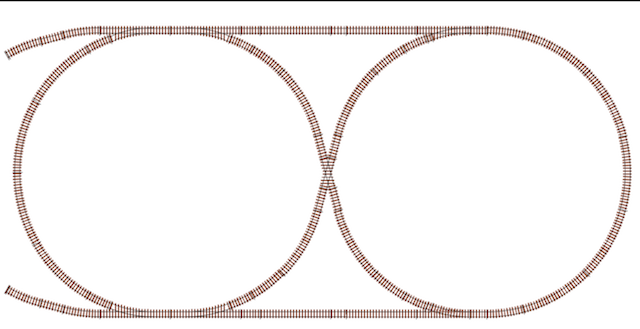 A purpose-built track plan was designed to contain, a loop, a figure eight and two reversing loops in the smallest possible space. The short sidings are for staging a second locomotive to demonstrate consisting two locomotives together or picking up and dropping off cars when doing prototypical operations. The table top measured 42" by 82". Although never used for its original purpose, it served me well. It was used for the first runs of my Dead Rail trains. It allowed me to continue to "Think Outside the Box" when it came time to build "My First HO Train Layout in a Long, Long Time". The construction details of this portable demo layout is archived here. Dead Rail Pros and Cons Pros
Cons
Who Should Consider Using Dead Rail?
The LocoFi™ system is one of a few that can be used to go Dead Rail. Other systems were previously noted. (April 5, 2023 The Soundtraxx Blunami sound decoder has since become available and is another possible Dead Rail Sound Decoder Option.) The LocoFi™ system was used because it was available at the time this project was started. It has proved to be very reliable, well thought out and very user friendly, plus the LocoFi™ Team is absolutely top notch in giving assistance and feedback. Using the LocoFi™ system, an old Android device (or new cheep one), 3 IMR Lithium-ion 350mAh 10440 batteries (Or multiples of 3), Four Lithium Iron Phosphate, LiFePO4 (LiFe/IFR), 10440 size batteries have also been used very successfully and are now, for the utmost safety, the battery that I use when ever possible. With a slight change in mindset, many more people can enjoy all the benefits of Dead Rail, HO scale, model railroading. Thinking "outside the box", can provide indoor benchwork that is both durable and sturdy and that does not require a lot of "expensive" lumber, woodworking skills and tools or a large vehicle or trailer to transport materials. The Fast Tracks' Bullfrog manual turnout controls are working great for Dead Rail. They come with a micro-switch that can be used for many purposes. They are extremely easy to assemble and install and work very reliably. A new system, for use with Dead Rail/Battery on Board, was released in Mid-August 2022. Soundtraxx announced its new Blunami system. They partnered with BlueRail Trains, which provides the iOS App to control all of the Blunami's features and control the locomotive. The iOS BlueRail Trains App can program the DCC CV functions graphically. CVs refer to configuration variables that are used to set up particular locomotive movements and sometimes the sounds, if so equipped, of DCC decoder equipped locomotives.
In my mind, the Middleton & South Haven is a point-to-point railroad with terminuses in Northville and South Haven and during operation sessions it is operated in that manner. In physical reality, it looks much differently. 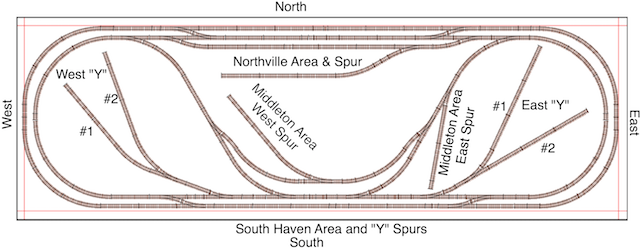 To assist the viewer of the YouTube video "My First HO Train Layout in a Long, Long Time - Part 6", that included several layout updates and an actual shunting session, I created a "map" of the track plan that showed the cardinal directions, area or district names and spur designations. The video only demonstrated a very short run, but there are a myriad of other possibilities for varied length and shunting possibilities. Besides a lot of shunting possibilities, the track plan also allows for the continuous running of two trains at a time when visitors just might want to see your model railroad. At this time, January of 2024, nothing is permanently attached to the foam insulation board table top. Everything is just straight pinned to the table top. On Monday, January 2, 2023 I purchased two Metalux SHP 4 ft. 128-Watt Equivalent, 10000 Lumens Integrated LED, White Shop Light, 4000K CCT, for $43.97 each, from Home Depot. They were installed, hung from the floor joists, over the center area of the layout. After the layout was moved to its semi-permanent location, it was leveled with a 4' level. The trains were run with the new "ceiling" lights on. At the beginning of February, all of the basement ceiling light bulbs were replaced with Universal 4-Panel Daylight LED Light Bulb light, 6000 Lumens, from Menards. They really brightened up the whole basement, as well as the darker ends of the layout. Do not purchase them! Unfortunately these 4-Panel Daylight LED Light Bulb lights didn't last. One stopped working in late February 2023, another in early March 2023, another at the end of March 2023 and one of the exchanged ones at the end of April 2023. The lights at. each end of the layout. were replaced with GT-Lite 4-Panel ADUSTABLE LED BULBS from Menards. They were $37.99 each. They have been working well since they were installed. In March of 2022 I attended two model railroad train "shows", two more near the end of January 2023, and one each in January and February of 2024. That means, that at this point in time, I've attended six train "shows" or sales. The January 2023 "shows" were;
The events that billed themselves as "Shows" featured local clubs' traveling model railroad modular layouts, in all scales, including Lego, with running trains on the landscaped modules. None of the "shows" included manufacture or vendor demonstrations of the latest products for model railroading. Only a few, very few, vendors, selling new railroad modelling supplies were present at any of the events. The events were mainly swap shops where individuals purchase tables to sell previously used or purchased model railroading items. The price of the items is usually substantially lower than new items of the same type. For the January 2023 Great Train Show I had a list of items that I was looking for and model railroad money in my pocket, but I found nothing on the list, or even somewhat "tempting" to purchase. I did find a vendor, a local hobby shop, at the Div. 6 train sale that had the Kadee couplers I was looking for.
I knew the retail price. I was able to save about $18 off the retail price for the three items by purchasing them at the sale. On the evening of Friday, February 17, 2023, I attended a meeting of the NMRA North Central Region (NCR) Division 6 (Div. 6) organization. There were about 30 to 35 people in attendance. They ranged in age from a teenager to eighty-ish, with the vast majority closer to the upper end of the age range. There was a "Clinic" on auto-rack cars, presented by one of the members. That was followed by show and tell on the topic of the evening, lumber. In turn, each member showed and described the model railroad item, in any scale, that they brought that related to logging, lumber and railroads. The Ann Arbor Model Railroad Club had a train show on Saturday, February 18 & Sunday, February 19 of 2023. It was similar to other swap shop shows with lots of previously owned items for sale.  I found two versions of the first Lionel engine that I owned, in 1957, for sale.  While I did not find any structures for the layout, I purchased a Riverossi 4-6-4 Hudson, in NYC livery, for possible conversion to LocoFi™ and Dead Rail. It has the long haul tender that should be usable as a battery car. The locomotive had a note on the box that said, "Runs well". At home, it was run on my train set track using the DC power supply and controller from that set. 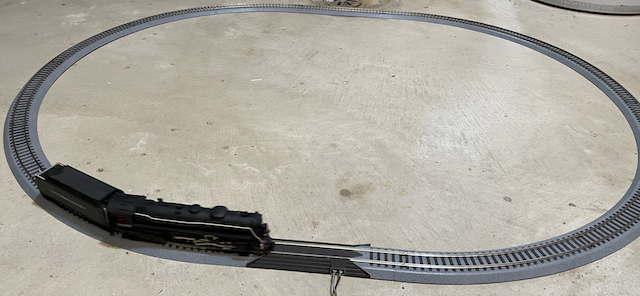 It appeared to run okay in both forward and reverse. I had a specific list prepared for The Great Train Show in January 2024. I was looking for a couple of HO scale trucks at a reasonable price, as well as a few "old time" passenger cars to pull behind the IHC 2-8-0 Consolidation as an excursion train. I didn't find anything useful at that show. I was able to procure all of the items on my list at the Ann Arbor Train Show in February, 2024. 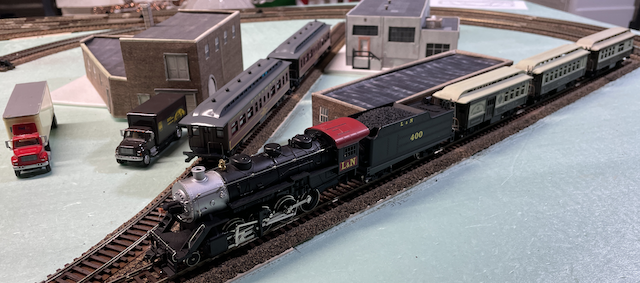 The purchased items are shown; 2 Pullman cars, 3 Overton passenger cars, a UPS box truck and a semi with a short trailer. (The IHC 2-8-0 Consolidation had been previously purchased off Ebay.) Unfortunately, the Pullman cars are unusable, at the present time, on my layout with 18" radius curves and foul on the Caboose Industries switch throws. Maybe they can be modified, as it is the steps that are fouling. Because the semi tractor and trailer were shrink-wrapped together when purchased, I could not tell that the trailer hitch pin was broken off, but it is an easy fix. Overall, I am happy to put someone else's equipment back into use at quite reasonable prices. Cardstock Structures There are several sites on the Internet that offer colored PDFs, of various structures, usually at a low cost, that are ready to print and assemble using cardstock. I became very intrigued with them when I watched Luke Towan's video "Paper Kits Have Never Looked So Good - Realistic Scenery Vol.35". Unfortunately, the laser cut kit he used in the video is not readily available. (Take note of Luke's views and numbers of subscribers on YouTube!) I found Sam Miller's videos on constructing cardstock structures for model railroading. He uses the PDF's from Clever Models although he did start out with the same building from Model Buildings that I chose to start with. In Sam's second video, he runs through some materials and tools that he uses but did not note them in the notes section of the video. Here are some things, that I noted in the 2nd video, that might be useful that I don't already have.
I used ModelBuildings.org and their free building to give this method a try. 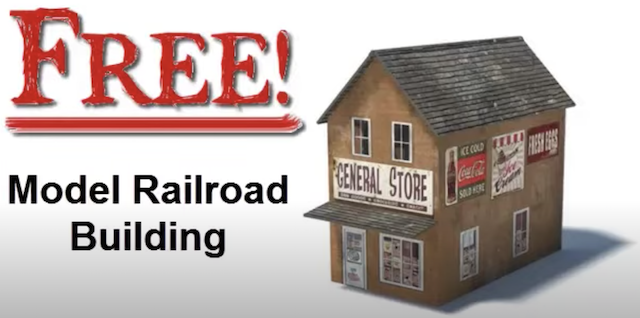 I downloaded and printed the free Model Buildings' General Store. The original PDF is in OO gauge size (1:76.2). HO scale is 1:87. 76.2 / 87 = 0.8758621 or 87.6% when rounded. With some research, I learned that my HP 2600 series printer cannot print on cardstock. Therefore, the building was printed on regular white computer printer paper. At Walmart, I purchased; Pen+Gear Premium White Index Card Stock, 8.5" x 11", 199 GSM, 150 Sheets, a Hyper Tough 3-inch Acetate Handle Scratch Awl, a tube of Eclectic E6000 Glue Industrial Adhesive with Precision Tip, Clear 1 oz. and a Fiskars 12" x 18" Self-Healing Cutting Mat. 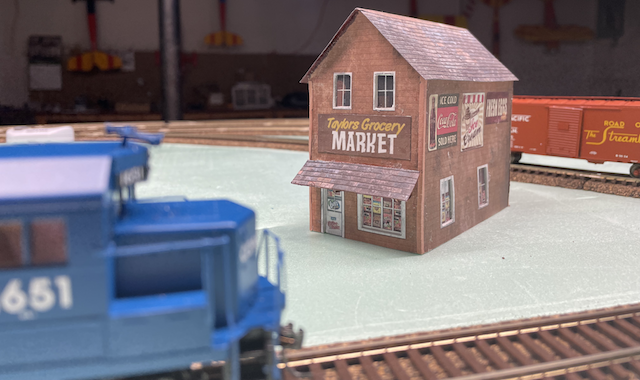 For a first attempt at building a cardstock structure, it turned out reasonably well. It was also a great learning tool. 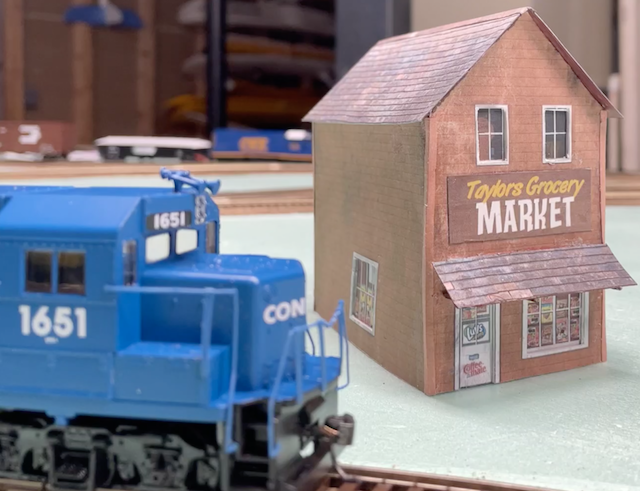 The construction photos and construction details have been archived here. Further research, on YouTube and all of the suppliers' Websites, provided even better ways to do things. Brent Harris O Gauge Model Trains, on YouTube, demonstrated a better way to cut out windows, doors, and very narrow pieces requiring interior cuts. I do not recommend the freehand cutting he uses in his demonstration. A straight edge works well. With a somewhat acceptable grocery store completed, it was time to start adding industries, warehouses and transfer points to the switching, shunting puzzle, layout. The ACME Transfer Warehouse, by Team Track Models, was chosen as the next building. I chose to build the Craftsman version. Steves Trains has a YouTube video about building the N-scale version of this structure titled, "Great Looking Paper Structures, Only $8!?". The ATC-HO.pdf, the structure prints, and ATC-instructions.pdf were purchased on Wednesday, March 15, 2023, and downloaded.
A lot of information regarding the types and weights of cardstock and the construction photos and details of the warehouse have been archived here. I need a minimum of seven destinations for prototypical shunting of rolling stock or rail car maintenance. They can include warehouses, transfer points, industries, railroad maintenance facilities, bulk plants, etc. A second version of the Team Track Models ACME Transfer Warehouse was built. The modified version moved the office to the end of the warehouse and used the graffiti walls on the warehouse structure. The stairway railing was also changed slightly.
The construction photos and details have been archived here. Why the HO Scale Crossing Tower Could NOT be used as a Learning Tool A third supplier of "Cardstock" models was tried. 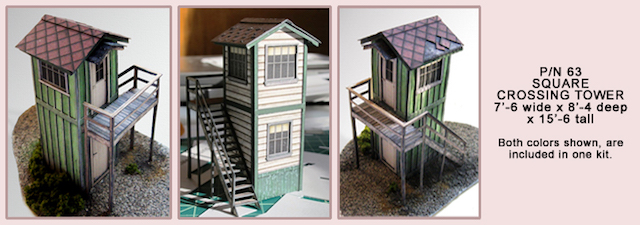
Photo from the Clever Models' Website The photo is of the O scale version. I downloaded the FREE "HO Crossing Tower Kit" from the Clever Models' Website. Even though I'd completed three of these cardstock structures at this time, I did not have the skill, technique and patients to complete this model in HO scale. I spent six days doing research and learning in an attempt to build this kit in HO scale. I learned a GREAT DEAL from not being able to actually construct this structure. A whole lot of what I learned is archived here. Even though I ran into a door sizing problem with the Clever Models Crossing Tower, which is explained in the archive, I continued to look at Clever Models because of Sam Miller's videos on constructing cardstock structures. I did have to keep in mind that he demonstrates building O scale structures and that some O scale structures do not scale down well to HO, as the parts become too small to be successfully cut out or manipulated. I looked through all of the Clever Models' structures and other cardstock kits. It looks like there are over 80 of them to choose from!!! 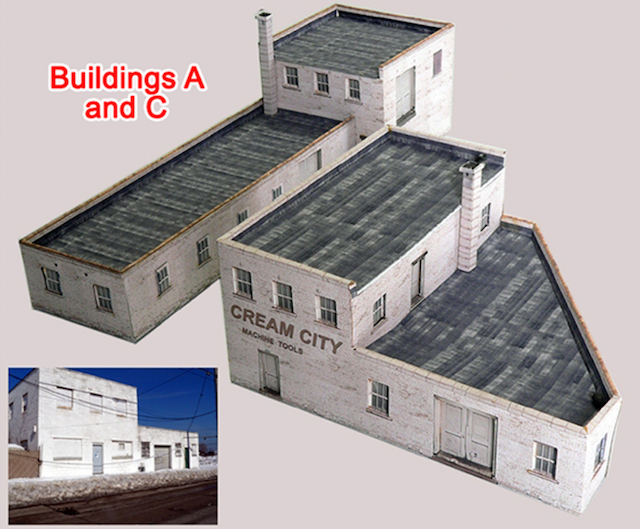 I was particularly drawn to the Cream City Tool Works complex, which I first saw in HO scale. The HO sized version was created about 2010 and is only available in the light colored brick texture.  I next found the O scale size version as a set of four separate buildings in a dark colored brick texture. I really liked the look of the dark colored brick texture. All four of the dark brick O scale Cream City Tool Works Buildings were ordered on May 1, 2023. Clever Models had a half off sale at that time. The four O scale cardstock kits, of the dark version, were released individually from the middle of August of 2020 through the beginning of March of 2021. That is a seven month period, which allowed the designer to make some changes to each building's construction techniques over time. Therefore, each individual building's construction notes and methods evolved and changed over that time period. Clever Models designs most of their cardstock kits, unless specified, to be printed at 100% for O scale. On their Website they added the following information, "NOTE: This kit comes in O scale with instructions to print in ANY smaller scale." To create the printed kit parts in HO scale, the printer is set to print at 55% of the original kit PDF. Using that method, I was able to create the HO scale dark version of the Cream City Tool Works complex in HO scale. A quick glance through the PDFs revealed that this could be an "interesting" and challenging build. Once started, it proved to be just that! All of the buildings in the photos are temporarily setting on scrap pieces of craft type foam board. As previously mentioned, when printed at 55% of the O scale version, many of the parts become too small to cut out and manipulate. I spent a lot of time in learning which parts to use, what methods worked well, and which ones didn't. By the end of July, 2023, I had created a downloadable PDF titled "Building a HO Scale Version of the Cream City Tool Works Complex Using Clever Models O Scaled Individual Buildings". This is an extensive How-To document demonstrating all of the techniques I used to successfully create this complex of buildings in HO scale. 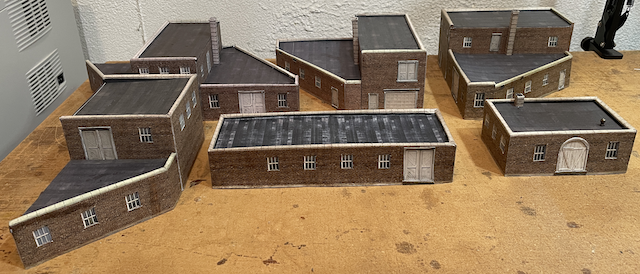
The Six Buildings By the time I finished, I had created two more buildings from this complex, and learned a whole lot more about building card stock (or cardstock) structures. 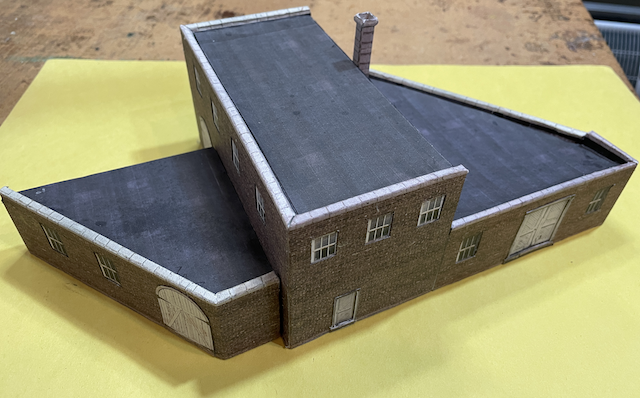
The 3rd Version of Building A I also created a Tools and Supplies list that I used to create these building. A YouTube video, that supplements the How-To, titled "Building Clever Models' Cream City Tool Works O Scale Kits for HO Scale" was posted on July 20, 2023. I currently have two playlists on YouTube. Making and Using a Portable Dead Rail Demonstration HO Layout has 10 videos. They cover my early discoveries about using Dead Rail for HO scale, and how I built a portable layout prototype to test out the practicality of using Dead Rail/Battery on Board with HO scale trains and alternate layout construction ideas. My First HO Layout in a Long, Long Time shows how my HO layout in a long, long time evolved, it's rather unique construction, and more information on using Dead Rail in HO Scale. It also contains information on adding cardstock structures. My Six Part Series on YouTube "Are You Ready to Give Dead Rail a Try?" Lots of details and examples in the videos. Everyday life has a lot to do with how much noticeable "work" gets completed on a model railroad layout. I had plans to get all of the structures spray painted with clear, flat Krylon this past summer. It never happened! There were also other "things" that had to do with the model railroad but that never show up on the layout. This is a list of things that were tackled, and mostly completed since the last structure was finished. 1. Paper templates were created in CAD for the "downtown area". They were printed, cut out, taped together and set on the layout. 2. Several attempts were made to layout the road system, but that project still needs to be completed. There was also a lot of research time on YouTube trying to figure out the best method for me to actually construct the various road types needed. 3. Several iterations were tried, on the X-Track CAD version of the layout, to create a 4 mile run between Northville and South Haven. This took a long time to come up with the best route, and a lot of time running on the layout to come up with a really workable route. A lot of time was spent doing a lot of actual running on the layout to discover the "best" route. 4. Several FREE updates for the LocoFi™ App were download and installed with new firmware being updated to the locomotives as well. 5. I was asked by Jim Kellow to prepare a LocoFi™ Dead Rail presentation for New Tracks Modeling for November 8. After working on the presentation for 8 to 10 hours a day for 6 days straight, I was told that it could not be presented until May of 2024. 6. A week was spent running trains a lot to see why I had a problem with LocoFi™ losing sound. It turned out to be all me accidentally hitting the sound icon on the phone because of the way I was holding it. 7. I was asked by LocoFi™ to create more shunting videos for my YouTube channel. I didn't think I had an appropriate camera, so a week was spent on YouTube, looking for one. It finally dawned on me that I had what I needed on hand. 8. I did a HUGE update to this Website, HUGE! It took weeks! And then I immediately did another update, which took another week!!! 9. I purchased and tested the Only Batteries LiFePO4, which proved to not be useful for our purposes. That also involved many days of running trains on the layout. 10. The coupler height was changed on the only tank car, as it was too high and often uncouple from other cars when being run in a train. 11. A lot of time was spent looking for a steam locomotive, DC only, that didn't cost too much and would be good to add a new LocoFi™ module for steam, which became available with upgrade 2.35. 12. An outside section of track, near the furthest west switch, was leveled better, as there was a noticeable dip there. (That was noticed when running the many, many, many prototypical runs for many reasons.) 13. Having reached the point where I can do prototypical running with a lot of shunting, I lost a bit of "drive" to get more structures, roads and scenery going, since I can "play" with the trains a lot now. 14. It also doesn't help that the Detroit Lions football team is doing well for the first time in about 60 years! 15. I also feel that I need to get out another video on my YouTube channel so that folks know that I've not disappeared and that I am continuing to run HO scale size locomotives using Dead Rail/Battery on Board power and LocoFi™. 16. I created a complete inventory of the model railroad items, supplies and other associated model railroading "things" that I had on hand. I boxed them and made a list of which box each item was in. 17. Once again, I worked for many days trying to come up with a "simple" way to identify the types of batteries that I use that have mislabeled capacity in mAh, and once again I was not successful! :-( Purchasing and actual testing appears to be the only way that works. X-Track CAD and an Alternative Tutorial for the Mac Only This link opens in a new tab and leads to MY version of The XTRACK CAD Wiki BeginnersTutorial. It can be saved to any computer's OS as it is a PDF file. MY version is MY rework of the Beginner's Tutorial that I created on a Mac. The original Tutorial is based on the Windows OS and there are some notable differences. Once I learned how to use X-Track CAD I found it quite easy to use, since I had had previous experience using a 2D design CAD program. RailModeller Express for Mac OS (Free) is the limited FREE version. Only 50 elements may be added to the drawing area. On April 11, 2023, this program, for the Mac OS ONLY, was downloaded. It was reasonably easy to use, and somewhat intuitive. RailModller Pro, for the MAC OS ONLY, costs $44.99, and it is the full version of the program. Both programs are extremely accurate. Both programs are less than straight forward in how to print from them. At first, I found them to not be as accurate as I was hoping for, especially with tracks moving on a diagonal between two straight sides of a loop when going from one turnout on an angle on one side to another turnout angle on the other side. Think reverse loop. This was not true. They are accurate in all dimensions. The "problem" is that when using sectional track, like Atlas Code 83 sectional track, the rail joiners provide a lot of "wiggle room". A Uni-track type, where the track is attached to the roadbed, is more accurate because it has no "wiggle room" when snapped together. Each end of the inside loop, according to both CAD programs, should have measured 37.5" inches between the centerline of the two long parallel sides of the loop. They didn't! The west end measured 38-3/16" and east end measured 38-1/16" from the centerlines of the two long parallel sides. The modeler should expect slight differences between the track plan provided by either of these CAD programs and the physical, real, sectional track when placed on the layout, and expect and correct for these differences. YouTube Videos New Tracks Modeling, September 27, 2023
New Tracks Modeling, June 13, 2020
The following linked video showed the most current information regarding LocoFi™, which was presented at the
1-15-22 NMRA Coast Division Virtual Event.
SMT Mainline: A young man reviews model train "stuff". He seems to be in Canada. This information was used to select the Walthers Trainline EMD GP15-1 as the choice for trying Dead Rail and LocoFi™.
Stan Ferris: Has been posting YouTube videos, on many topics, for 11 years. For the last couple of years his videos have concentrated on railroading and model railroading. He does many, many different scales.
All videos posted by BlueRail on YouTube the most recent one posted was dated Dec 12, 2020.
Peter Stienmetz
Separating power loc track
Railpro on battery power (deadrail)
Layout Design and Track Planning and Track Laying Refurbished 4x6 foot twice around Pennsylvania diesel freight train set for sale
Old setup 4 x 6 HO layout
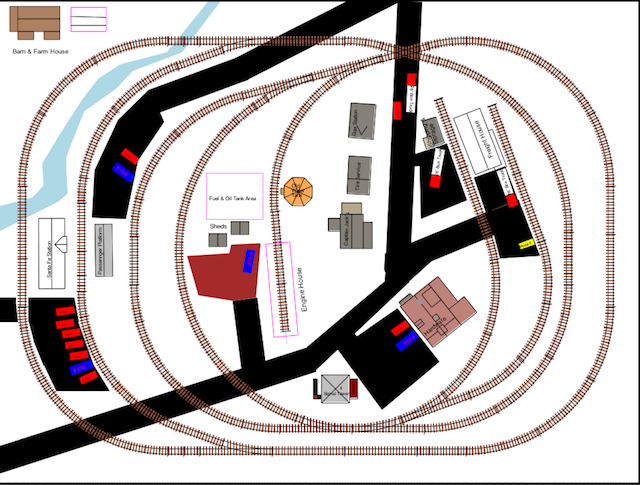
X-Track CAD for my twice around. I got a bit carried away with the details. A Beginners guide to: Using XTrkCAD for designing layouts.
The evolution of a track plan is demonstrated in the following three videos.
S03E10 - The How, the What and the Way to Start Building YOUR Railroad
A fast, easy and free way to plan a layout with realistic constraints
Layout Intro in Anyrail and 3D demo
How To Build a MODEL TRAIN LAYOUT. Easy and Smart Ideas
107: Rebuilt My Layout The Regular Guy Way!
5 Tips for Small Model Railroads
Laying Flex and Sectional Track (without nails)
37 - Model railroad turnouts explained and compared. Atlas, Peco, Walthers & Micro Engineering
The BullFrog Manual Turnout Control
Model Railroad Scenery: Getting rid of that FLAT look. Easy and fun, HOW TO
Rolling Stock & Locos
Fast Tracks laser cut turnout controls called The Bullfrog. They connect physically and require no power. Simple, inexpensive kits that should be perfect for Dead Rail operations. They have videos on their Website and YouTube that cover the simple assembly and use. LocoFi™ This is the LocoFi™ homepage. This is where to start when learning about the LocoFi™ system. NMRA National Model Railroad Association Homepage. Includes a lot of very useful information on getting started with Model Railroading and a lot more. The XTrackCAD Wiki HomePage This is where to start learning about this FREE track/layout planning program. BlueRail This system uses the Blue Tooth found in Smart phones and "Pads", both Android and iOS. Tam Valley Depot Their homepage. CVP Air Wire This system requires their proprietary throttle to operate the locomotive and much more. S-Cab This system requires their proprietary throttle to operate the locomotive. Kadee Couplers The original magnetic uncouplers that are copied by many now that their patent has run out. Atlas All-Scales Track & Accessories Catalog Atlas is a long time supplier of track, accessories and more. This PDF catalog contains many track plans. Walthers HO scale GP15-1 diesel locomotive An EXCELLENT review of this locomotive via Model Railroader Magazine. This is the way that reviews should be done!!! Peter Steinmetz Mr. Dead Rail Installs Richard Garthe a user of LocoFi™ RailPro Users Group This is a private group Adding a Lithium-ion battery protection circuit module (PCM) adds a lot of safety for the end user of the battery. It stops the battery from being over charged, as well as not allowing the voltage to go too low. Both over charging and running down the battery too far can possibly lead to catastrophic failure of the battery. The PCM protects the battery and end user from a faulty or poorly designed charger, as well as human error, it also brings the depth of discharge (DoD) into play by allowing the battery to be deeply discharged before it "automatically" shuts down the battery. While there is some variation in thought as to how much this affects Lithium-ion batteries in general, and the 4.2V type especially, it is still a consideration. How much the battery voltage (the locomotive's speed) drops during a full capacity discharge may or may not be noticeable by the operator depending on the operational conditions. If a PCM is used with a DC to DC voltage converter, used to keep the supplied voltage fairly constant, it could lead to possible Depth of Discharge (DoD) issues, as it would be very hard to note when the locomotive's battery pack is actually "running down". Using a Google search, I've found photos of covered gondolas, so I'm planning on making and using a cover on the gondola. I've also been trying to find some foam board with the true dimensions given. Both the Adams (Dollar Tree Foam Board) and Ross (Walmart foam board) are not cut squarely. That makes layout planning difficult, as I do want to continue to explore using foam board to create my "real" layout. I have physically gone into stores and online looking for foam board with true dimensions and square corners and have not been successful to date. I ran a test to see if using 1 Step would show an indication of the battery running down on the speedometer in the App.
The 4 IFR batteries were charged on the SkyRC MC3000 Charger at 0.30A to a termination of 3.60V.
I took a break and rested the train for about 10 minutes between the second and third runs. At the end of the 45 minute run time, the MC3000 noted the open circuit voltages as;
Recharge and noted returned mAh -
Guesstimate of actual discharge based on 97% returned mAh
The 45 minute run time and was also confirmed with the recharge returning 0.235mAh to the battery. I think that by setting the max speed, it always indicates 65 mph at full throttle no matter what the voltage is. So this is not a viable way to test when to stop running. Back on May 24, 2022 I made a mistake trying to run 4 IMR batteries that cost a lot of run time, as the voltage allowed too high of a current to be drawn. I thought that by reducing the 4 IFR batteries to 3 IFR batteries that the prototypical run time would be increased and performed the following test. I tried using 3 IFR, because the train seemed too fast on small layout when using 4 IFR at full throttle, 65 mph. I thought that only using 3 IFR would considerably lower the average amp draw and increase the prototypical run time while keeping speed down just a bit. I also tried 1 Step to see if the speedometer indication changed with the battery discharge. It didn't, The CSX was configured using 1 step, but I ended up setting a maximum speed, as the default appeared to be 20 mph, and named the new configuration 10.
This test was a failure. The CSX, with the 3 IFR stopped working at 48 minutes and 20 seconds. The MC3000 displayed the open circuit voltages of battery #1 3.05V, battery #2 2.90V & battery #3 2.59V when I got them on the charger. I had run them down farther than intended. :-( When the charger was started for a full charge, only battery #1, in slot #1 started to charge at 0.30A. Batteries #2 and #3 started at 0.15A. It didn't take long for battery #2, in slot #2, to ramp up to 0.30A, but it took longer for battery #3, in slot #3, to ramp up to 0.30A, for its charge rate. This was a learning experience for how this charger works.
The mAh returned by the charger to fully charge the discharged batteries:
This is a good example of some of my dead end testing. Installing LocoFi™ in a Walthers Trainline CSX EMD GP15-1 For Dead Rail Using a 3S 11.1V 300mAh Lithium Polymer (Li-Po) Battery
The Walthers GP15-1 Conrail with an IMR Lithium-ion 4S 350mAh resultant battery Installed in a Gondola
This section originally explained why trying a 4S IMR 10440 size resultant battery pack was a mistake and why it was changed to a 3S 10440 350mAh resultant battery in the section "The Conrail Converted from a 4S IMR 14.8V 350 mAh resultant battery to 3S IMR 11.1V 350mAh Resultant Battery and Its Effect on Run Time". Some information on this is can be found here.
The Conrail Converted from a 4S IMR 14.8V 350 mAh resultant battery to 3S IMR 11.1V 350mAh Resultant Battery and Its Effect on Run Time
To reduce the amp draw and increase the run time, the number of batteries was REDUCED, yes I noted REDUCED, to lower the applied voltage and thus drop the amp draw!
Based on the information from the original CSX Li-Po battery conversion and other battery testing, I changed the 4S IMR 10440 350mAh resultant battery, used for the Conrail, to a 3S configuration by modifying the rear AAA battery box.
The section on how I modified one of the two AAA battery boxes to provide a three in series (3S) resultant battery is not NECESSARY! That information is archived here.
A better method is to use one of these Dummy Battery AAA Size Placeholder Cylinders in one of the battery compartment's holders, which then creates a three in series resultant battery.
MicroMark Micro Connectors are now recommended.
The Conrail was reconfigured in LocoFi™ to now use a 3S IMR Lithium-ion 350mAh 10440 size resultant battery.
Video showing the new, 3S, configuration running is here.
Because the original Derived Run Time Procedure is no longer used, the original of this section was archived for reference and opens in a new tab.
An updated version of this section was also completed, it to was also archived and will open in a new tab. It contains a lot of information on using the 3.5V cut off and a lot of mathematical proofs.
The bottom line was that the locomotive could have a prototypical actual run time of more than 40 minutes. (Later, it was proven to have an actual prototypical run time of 60+ minutes.)
Since the Derived Run Time Procedure test, noted in this section, is no longer used. The actual run time procedure is now noted in the section titled, "The Procedure to Determine the Actual Run Time Using Three IMR or INR 10440 Size Batteries ".
| ||||||||||||||||||||||||||||||
